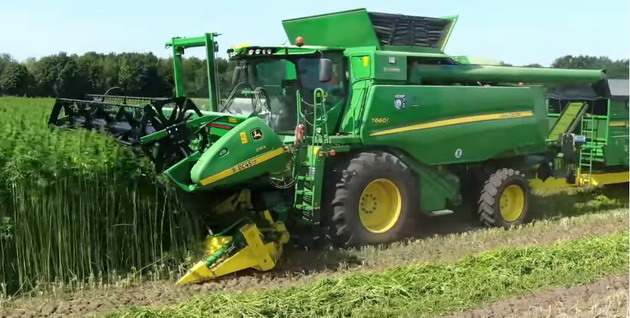How Can Industrial Hemp Reduce Plastic Pollution

The industrial pollution produced by our civilization managed to drown us in plastics that invaded the oceans and also the landfills.
Many of us are trying to recycle plastics and other materials to stop them from invading our natural habitats, but the recycling process will only produce new plastics from the old ones, and this way, our society receives a constant supply of plastics every day, and not all of them end up being recycled.
To solve the plastic pollution issue on the planet we need to replace plastics made of petroleum with different materials that are environmentally-friendly.
Giving the fact that oil is a finite resource and plastics produced from oil are harming the environment, it is more than obvious that our civilization needs to use different materials produced from renewable resources (biomass), which are sustainable and safe for the environment.
Industrial hemp is a plant that was used and cultivated for thousands of years on our planet, and because every single part of this plant can be used, we can transform the today’s industries that are contributing to the destruction of the environment, into industries that are protecting the environment.
I already mentioned that we can use every single part of this plant, from the fibrous stock to the inner woody core of the plant, the flowers and the seeds of the plant.
Industrial Hemp and its Many Uses
Hemp grows faster than trees, and takes less water to obtain the fiber we use for millions of products. Our goal is to spread the word about how replacing trees with hemp is eco friendly because we want to help our environment stay in optimal condition.
The fiber of this plant is extremely strong, and can be used to replace fiberglass, to produce stronger, cleaner and safer bodies and interiors for cars.
The body of a car containing hemp fibers is stronger than steel, and is also lighter, which reduces the fuel consumption of the vehicle.
Hemp fibers can be used to address the plastic pollution in our oceans and landfills by creating bioplastics.
Bioplastics are superior materials that can biodegrade and become compostable, so by replacing all plastic bottles used today with bottles made of bioplastics, we can simply throw them after usage in the composter because they will decompose very fast.
If we stop producing petroleum-based plastics that can live hundreds of years in the environment without degrading, we need years to clean the oceans and the landfills that have been invaded by plastics.
Shifting Over to Bioplastics
However, by shifting over to bioplastics we can stop adding to the problem.
Bioplastics are plastics made of renewable resources such as biomass, and hemp fiber is the perfect material for the production of biodegradable plastics.
Instead of using cotton (that consumes a large amount of pesticides and water to grow), we can use hemp that takes half the land and water to produce two pounds of fabric.
In today’s world where climate change has become a reality for our civilization, we can no longer waste the precious natural resources such as water.
We need to focus on crops that use less water and pesticides to protect the land and water resource.
Instead of producing paper from trees, we can use hemp paper.
Producing paper from wood takes two decades and four acres, while producing the same amount of paper from hemp we only need one acre and three months.
The environmental impact of shifting to hemp fibers can bring as superior bioplastics, safer, stronger and more efficient vehicles, sustainable paper and fabrics.
The inner woody core of the plant is called herd and is used for animal bedding due to its absorbent properties.
Being able to absorb as much as four times of its weight, the hemp herd can be used for soaking up oil spills.
Hempcrete Uses
Hemp is also used in the construction sector because today we already have homes built from hempcrete.
Hempcrete is a green alternative to concrete because it’s strong, affordable, lightweight, absorbs carbon emissions, and has superior thermal and insulation properties.
Hempcrete is obtained mixing hemp herd with lime binder and some water, and we get a green concrete that can be used in flooring, walls, as plaster and for insulation.
Homes built with hempcrete can last for centuries, and the proof can be found in bridge abutments made with hemp mortar (Merovingian bridges) in southern France in the 6th century.
Hemp seeds can be eaten raw because they are very tasty and healthy for the human body, containing complete protein, omega-3 fatty acids, and minerals like Magnesium (Mg), Zinc (Zn) and Phosphorous (P), and they are high in fiber and low in carbohydrate.
Vegans Appreciate Hemp Seeds
Vegans, vegetarians and any person who prefers to eat healthy food will appreciate these seeds for their awesome properties.
The oil obtained from pressing hemp seeds can be used to produce hemp fuel (biodiesel), which burns cleaner, and can become an affordable alternative fuel to conventional fuels because hemp grows faster and has a higher yield compared to other crops used to produce fuels.
Hemp stalk can be used to produce ethanol, and because hemp grows faster than other crops, we can keep corn for human consumption instead of using it for biofuel production.
A 2014 Farm Bill allowed Americans to grow hemp on a very small scale, but in the summer of 2018, the U.S. Senate passed a new farm bill to allow America grow hemp legally.







